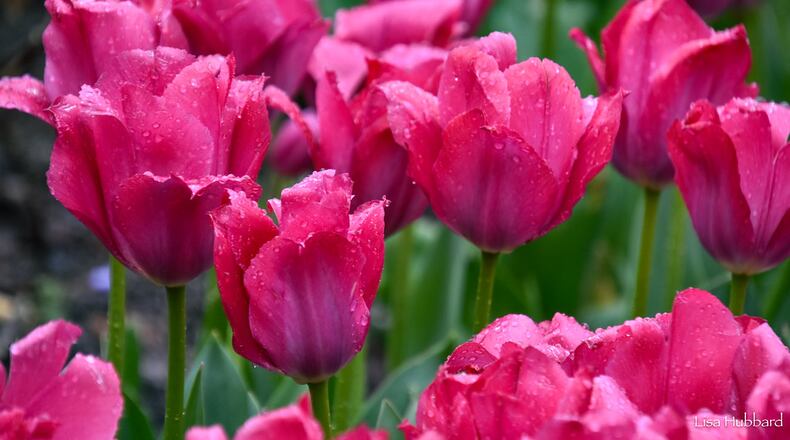The Journal-News spoke with Steve Foltz, director of Horticulture at the Cincinnati Zoo & Botanical Garden, who said the zoo aims for a celebration of spring blooms.
As one of two accredited botanical gardens in Ohio, the award-winning Cincinnati Zoo is open from 10 a.m. to 5 p.m. daily and is open year-round. Zoo members receive early entry access and may enter the zoo at 9 a.m. The Cincinnati Zoo & Botanical Garden is located at 3400 Vine St., Cincinnati.
The zoo’s Tunes & Blooms concert series runs in conjunction with Zoo Blooms, and it will continue every Thursday in April from 5 to 8:30 p.m. On Thursdays, during Tunes & Blooms, admission is free after 5 p.m. Parking is $10. The music starts at 6 p.m. Upcoming dates are April 18, April 25 and May 2.
For more information, or to purchase tickets, go to cincinnatizoo.org. There is no additional cost for Zoo Blooms, it is included with the price of admission to the zoo.
Question: What goes into preparing for Zoo Blooms each year?
Steve Foltz, A: Usually, we get our bulbs in September-October of the previous year. We have to be planning what color scheme, and what types and varieties we’d like to use ... It usually takes about three weeks to plant the 100,000 tulips, and that’s getting the beds prepared, laying out the bulbs, and we rely on lots of help, including volunteers, and students, and anyone who is willing to plant tulip bulbs during that time of the year is always welcome ... And, of course, with all the squirrels, we have to net the beds to keep the squirrels out, or at least try to keep the squirrels out of the beds, so they don’t get in and start pulling out the bulbs and moving them around.
Also, throughout the whole year, we are constantly looking at areas we can improve. We do a lot of minor bulbs in the fall as well ... We use a lot of shrubs like Viburnums that do a really nice job in the spring. Some of them are very fragrant, so as you walk through the zoo grounds, there’s a lot of different fragrances with the hyacinths, viburnums, lilacs, so that’s a very important part of the strategy as well.
Q: How do you determine what you’ll plant where, what goes well together, the overall plan?
A: Where to plant? That’s always a great question. We like to do what we call our color displays, whether they are tulip displays in the spring, or in the summer, those tulip beds turn into annual trial areas, where basically, we trial 500 to 600 different varieties of annuals that will go in those tulip beds. So, those are more of our color spots. We like color spots at the entryway, where people gather, maybe near restaurants, or near gift shops, and those common, open areas.
When it comes to our habitats, we generally don’t do a whole lot of color displays near our habitats. Habitats are more for the animal and the region, and where it comes from, whether it’s an African Lion, or whether it’s an Asian Elephant. Those areas will be treated differently, and they’re more naturalistic. There are more plants that look like where the animal comes from. If it’s an African Lion, it would be more grassland, or if it’s an Asian Elephant, it would look more tropical, large leaves, and things like that.
And, considering we are a botanical garden, we really like to keep as much diversity as possible. Our goal is to trial everything from an annual, perennial, shrubs, trees and vines, and trial all of those plants in all the different areas we have at the zoo to see how they perform in our Midwest, and through those trials, through constantly using the best plant material, we will be able to offer suggestions to people with home landscapes, saying, here are the best vines at the zoo, or here are best annuals at the zoo.
So, it’s a dual purpose. One, it’s just for display and use in the zoo, but really we are trialing all the best from companies all over the country to weed out the plants that don’t grow well here, and the ones that do well here, we want to make sure to pass that information along to our visitors, and on to the people of the Midwest, including nurseries, garden centers, and landscapers as well as growers, and we all work together. If you’re going to spend money on plants, we want you to be able to select ones that are going to do well in our area.
Q: What is the zoo most proud of as far as being able to bring Zoo Blooms to Cincinnati?
A: For me, if you go around places, you see a few flowering plants here and there. When you come to the zoo, you get a really good idea of just how many beautiful plants there are, and every day you come to the zoo, there’s something new in bloom, something different, and it’s such a constant. We have so many plants in a small space. The zoo is only 70 acres. It’s a small piece of land, but as you walk through the zoo, there’s always something new in bloom ... When the tulips are done, we dig our tulips out, and we have a plant sale, and sell the tulips as a donation to get some money back so we can redo the display the following year, but then, that allows us to immediately go into our annual trials plantings... The color has such an impact on the visitors, and the attitudes, and feelings of people, and I find it especially important. It’s one of the key parts of what we do at the zoo, and I think it’s well worth it.
About the Author

